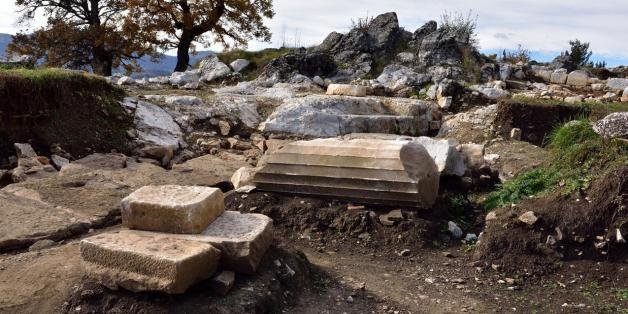At an altitude of 1,200 meters (perhaps the highest archaeological excavation in Greece) in Pindos, the archaeologists found themselves "face to face" with the ruins of an unknown city of the 4th century BC.
After more than 17 years of excavations by a small group of archaeologists from the Aristotle University of Thessaloniki (AUTH) with particularly limited funds, which did not involve a "resonant" and impressive revelation, the scientists managed to yield important results and findings - but not the identification of a specific ancient city.
The fragments of inscriptions with the letters "IER...", "IERO..." (sanctuary) that were found in Kastri - a fortified citadel of an ancient city of the country of the Tymphaeans, part of the kingdom of Macedonia, of the 4th century BC, lead archaeologists to speculate that this is a particularly important position of the ancient Macedonians with temples and places of worship, but the exact name of which remains unknown.
"Although the findings are numerous and important, the name of the god worshiped in the temple and the name of the city are still stubbornly hidden. However, all the evidence, the geographical location, the findings and even the years of the heyday of the acropolis at the end of the 4th c. BC, betray its importance within the historical context of the kingdom of ancient Macedonia" emphasizes - among others - in her introduction the head of the excavation team - now professor emeritus of the AUTH Stella Drougou.
In the wide area of the acropolis wall, on its western side, the remains and foundations of a remarkable building complex dating back to the last years of the 4th century were identified. BC: On the large plateau of the hill, the stone-built temple, the Doric portico and another large building are gathered around a four-sided 'square' and in direct contact with the large western gate of the fortified enclosure that protected the acropolis.
The archaeological finds
The archaeological findings showed that the acropolis "lives" until the years of Roman dominance in the kingdom of Macedonia, approximately until 150 BC, when it was destroyed. The shapes of the buildings can now be clearly seen, the mobile findings prove the importance of the location and the set of ancient remains promise much more for the future.
The initial guesses of archaeologists
The systematic excavation research in Kastri brought to light large parts of the fortified citadel of the ancient city, which, as the findings prove, has a religious character. Despite the extensive destruction noted in the remains of the acropolis, the coins, the characteristic imported and domestic pottery, the various metal objects, reveal an organized economy and consequently an organized life of the city. Excavation evidence and findings, architectural members and coins date the uncovered settlement to the end of the 4th/early 3rd c. BC, while the destruction of the acropolis, which must have been violent, is placed in the middle of the 2nd century. e.g. The multitude of bronze arrows and the extensive traces of fire indicate the cause of the war.
The initial guesses of the archaeologists regarding the identification of the city with the ancient "Aiginion" could not be verified - at least for now and based on the findings studied to date - to be confirmed.
"All these data precisely erase the next goal of this excavation on the eastern slopes of Pindos with the certainty that in the future a very interesting and special archaeological site can be formed there" concludes Ms. Drougou.








